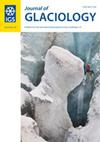Detection of crevassed areas with minimum geometric information: Vernagtferner case study
IF 2.6
3区 地球科学
Q2 GEOGRAPHY, PHYSICAL
引用次数: 0
Abstract
Crevasses pose severe risks for mountaineers and field glaciologists. Smaller cracks between 0.5 and 2 m are still dangerous, but often not visible in medium resolution satellite imagery. If they are snow covered, they are completely undetectable by optical sensors. We set out to develop an approach to detect potentially crevassed areas by a minimum of geometric data, and to make the method generally applicable to glacier regions. On Vernagtferner, we compared a reference dataset of crevasses observed in high-resolution optical imagery with the curvature of the ice surface and the spatial gradients in driving stress. Both parameters can be derived from a digital surface model and a bedrock model, derived from ice thickness measurements. The correlation patterns show that crevasses preferably form in convex areas and in areas where the driving stress rapidly increases. This corresponds with the theory of crevasse formation. Although the method still misclassifies larger parts, the approach has the potential to define probable non-crevassed areas as well as to aid the planning of safe routes.用最小几何信息检测交叉区域:Vernagtferner案例研究
裂缝给登山者和野外冰川学家带来了严重的风险。0.5到2米之间的较小裂缝仍然很危险,但在中等分辨率的卫星图像中通常看不到。如果它们被雪覆盖,则光学传感器完全无法检测到它们。我们着手开发一种方法,通过最少的几何数据来检测潜在的裂缝区域,并使该方法普遍适用于冰川区域。在Vernagtferner上,我们将高分辨率光学图像中观察到的裂缝参考数据集与冰面曲率和驱动应力的空间梯度进行了比较。这两个参数都可以从数字表面模型和基岩模型中得出,基岩模型是从冰厚度测量中得出的。相关模式表明,裂缝最好形成在凸起区域和驱动应力迅速增加的区域。这与裂缝形成的理论是一致的。尽管该方法仍然错误地对较大的部分进行了分类,但该方法有可能定义可能的非裂缝区域,并有助于规划安全路线。
本文章由计算机程序翻译,如有差异,请以英文原文为准。
求助全文
约1分钟内获得全文
求助全文
来源期刊

Journal of Glaciology
地学-地球科学综合
CiteScore
5.80
自引率
14.70%
发文量
101
审稿时长
6 months
期刊介绍:
Journal of Glaciology publishes original scientific articles and letters in any aspect of glaciology- the study of ice. Studies of natural, artificial, and extraterrestrial ice and snow, as well as interactions between ice, snow and the atmospheric, oceanic and subglacial environment are all eligible. They may be based on field work, remote sensing, laboratory investigations, theoretical analysis or numerical modelling, or may report on newly developed glaciological instruments. Subjects covered recently in the Journal have included palaeoclimatology and the chemistry of the atmosphere as revealed in ice cores; theoretical and applied physics and chemistry of ice; the dynamics of glaciers and ice sheets, and changes in their extent and mass under climatic forcing; glacier energy balances at all scales; glacial landforms, and glaciers as geomorphic agents; snow science in all its aspects; ice as a host for surface and subglacial ecosystems; sea ice, icebergs and lake ice; and avalanche dynamics and other glacial hazards to human activity. Studies of permafrost and of ice in the Earth’s atmosphere are also within the domain of the Journal, as are interdisciplinary applications to engineering, biological, and social sciences, and studies in the history of glaciology.
 求助内容:
求助内容: 应助结果提醒方式:
应助结果提醒方式:


